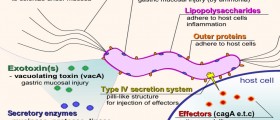
About gastritis
Gastritis is a condition that involves the lining of the stomach, called mucosa. Mucosa plays a very important role in digestion- it secretes stomach acid and digestive enzymes that help break down food for further digestion. The lining would otherwise irritate the lining of the stomach if there was not for mucus that is also secreted, which protects it.
When the lining of the stomach is inflamed, it produces insufficient amounts of enzymes, acid and mucus. That condition is called gastritis.
Gastritis can be acute and chronic. Acute gastritis is characterized by occasional or one-time bout of sudden and severe inflammation, while the chronic form lasts longer.
Chronic gastritis should be reported to a doctor and treated because it can cause ulcers and permanent damage to the stomach lining.
Causes of chronic gastritis
Helicobacter pylori or H. pylori is one of the most common causes of non-erosive gastritis. This bacterium is primarily transmitted through direct contact from person to person, but in areas with poor sanitation standards the infection may be due to consumption of contaminated food or water.
As for the erosive gastritis, characterized by the wearing off of the lining in the stomach, its most common cause is prolonged use of non-steroidal anti-inflammatory drugs.
Other, less common causes of gastritis, include injury or trauma, autoimmune disorders, other digestive disorders, viruses, parasites and bacteria other than H. pylori.
Symptoms of chronic gastritis
While acute gastritis usually involves sudden onset of rather severe symptoms, in chronic gastritis the symptoms may be mild but constant or very frequent. Many people who have gastritis do not experience any symptoms at all, which is called asymptomatic gastritis. However, even in those cases, if the condition is not treated, the symptoms will eventually start showing.
The typical symptoms of gastritis include pain or discomfort in the upper abdomen, nausea and vomiting. The general term for these symptoms is dyspepsia.
In erosive gastritis, when the lining of the stomach starts bleeding, the symptoms will include blood in vomit and stool and black or tarry stool.
Diagnosing chronic gastritis
In order to positively diagnose chronic gastritis it is necessary for the patient to exhibit the symptoms of gastritis for a prolonged period of time, with frequent bouts of symptoms. The diagnosis is usually made based on a procedure called endoscopy, in which a thin tube with a tiny camera on its end is inserted into the stomach.
Other tests may include upper gastrointestinal series, blood tests, stool tests and tests for H. pylori.

















Your thoughts on this
Loading...